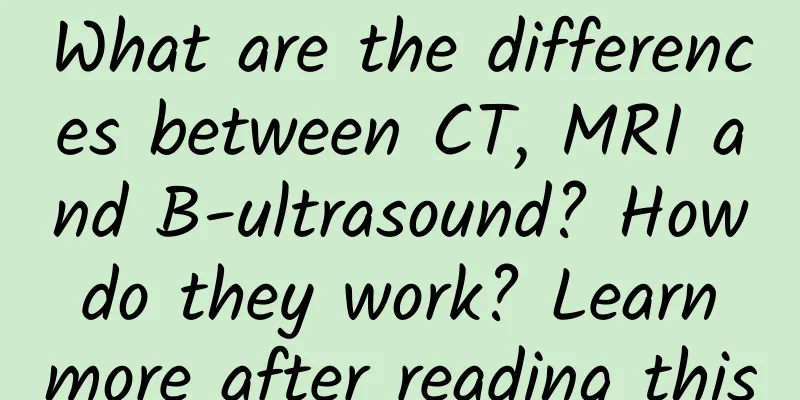What are the differences between CT, MRI and B-ultrasound? How do they work? Learn more after reading this

|
Simply put, CT, MRI, and B-ultrasound are all devices that diagnose diseases by looking through the internal structure and organs of the human body and comparing them with the normal physiological state. They are important diagnostic methods in modern medicine, and these devices will become more and more sophisticated in the future, playing an increasingly important role in human health and disease. These devices are all based on the discoveries and research results of modern physics. They use certain media to pass through the human body, obtain images of the human body, and analyze and diagnose health conditions through images. The biggest difference between them is that they use different media to pass through the human body, so the diagnosis sites and effects are also different. Now let's take a look at the basic situation of these three types of equipment: CT CT is the abbreviation of Computed Tomography. The main inspection medium used is X-rays. Through the penetrating X-rays to scan the body, images of the scanned parts are obtained through highly sensitive detectors. It has the characteristics of fast scanning and clear images. X-rays are high-energy electromagnetic waves, and are also a wavelength of light, so they are also called X-rays. The visible light that our eyes can see has a wavelength of about 380~780nm (nanometers), while the wavelength of X-rays is extremely short, only 0.001~100nm, and the frequency is also extremely high, above 10^16Hz. The energy is tens to hundreds of thousands times that of visible light, so it can cause damage to human cells and DNA. X-rays have extremely strong penetrating power. When penetrating the human body, they will form different absorption rates according to the different densities of different tissues in the human body, leaving black and white images with different grayscales on the photographic film. Doctors can observe and analyze these images to obtain the state of the internal tissues of the human body and make a diagnosis of the disease. CT was developed based on X-ray fluoroscopy. CT uses a rotating device to perform a cross-sectional scan of the human body like cutting carrot slices. The highly sensitive detector receives the penetrating rays through the rotating device and inputs the obtained data into the computer, which decodes the data and reconstructs the image. The main components of CT equipment include three parts: the scanning part, which is composed of an X-ray tube, a detector and a scanning frame; the computer system, which stores and calculates the information data collected by the scan; and the image display and storage system, which displays the computer-processed and reconstructed images on a TV screen or uses multiple cameras or laser cameras to capture the images for doctors to observe. Today's CT equipment has been updated from the first generation to the fifth generation. At the beginning, the scanning area was very small, the scanning time was long (several seconds), there were few detectors (only one or two), and the resolution was very low. Now the scanning area has been greatly expanded, the spatial resolution can reach 0.4mm (millimeter), the scanning time has been shortened to 40ms (milliseconds), and it only takes 330ms to scan 64 layers of images. The scanning method has changed from being able to only move horizontally to now being able to do plain scanning, enhanced scanning and contrast scanning, and can also achieve three-dimensional dynamic images. Magnetic resonance imaging Magnetic resonance imaging is also known as spin imaging or magnetic resonance imaging, which is the English translation of Magnetic Resonance Imaging, abbreviated as MRI. Magnetic resonance imaging is a very complicated process that detects physical changes at the atomic level through an external gradient magnetic field to draw an image of the internal structure of an object. As a popular science article, I will not explain it in depth. For your convenience, some imaging principles are quoted as follows: Atomic nuclei spin and have angular momentum. Since nuclei are charged, their spin generates magnetic moments. When atomic nuclei are placed in a static magnetic field, the originally randomly oriented dipole magnets are acted upon by the magnetic field force and become oriented in the same direction as the magnetic field. Taking the proton, the main isotope of hydrogen, as an example, it can only have two basic states: "parallel" and "antiparallel", which correspond to low energy and high energy states respectively. Precise analysis proves that the spin is not completely consistent with the magnetic field, but is tilted at an angle θ. In this way, the dipole magnet begins to precess around the magnetic field. The frequency of precession depends on the strength of the magnetic field. It is also related to the type of atomic nucleus. The relationship between them satisfies the Larmor relation: ω0=γB0, that is, the precession angular frequency ω0 is the product of the magnetic field strength B0 and the magnetic gyrometry ratio γ. γ is a basic physical constant for each nuclide. The main isotope of hydrogen, the proton, is abundant in the human body, and its magnetic moment is easy to detect, so it is most suitable for obtaining nuclear magnetic resonance images from it. From a macroscopic point of view, the phase of the set of precessing magnetic moments is random. Their combined orientation forms a macroscopic magnetization, represented by the magnetic moment M. It is this macroscopic magnetic moment that generates the nuclear magnetic resonance signal in the receiving coil. Among a large number of hydrogen nuclei, about half are in a lower state. It can be proved that there is a dynamic balance between the nucleons in the two basic energy states, and the balance state is determined by the magnetic field and temperature. When the number of nucleons that transition from the lower energy state to the higher energy state is equal to the number of nucleons that transition from the higher energy state to the lower energy state, "thermal equilibrium" is reached. If radio frequency energy that matches the Larmor frequency is applied to the magnetic moment, and this energy is equal to the difference in magnetic field energy between the higher and lower basic energy states, the magnetic moment can jump from the lower energy "parallel" state to the higher energy "anti-parallel" state, and resonance occurs. Let's understand it in simple terms: the human body contains 60-70% water, which is distributed in every cell and various tissues and organs, and the water content of different tissues and organs is different. Some people compare MRI to grabbing a bottle of water, shaking it, and then checking the changes in the bubbles that are shaken. Under normal circumstances, the direction of the magnetic field lines of each water molecule is random. When under the strong magnetic field of nuclear magnetic resonance, the magnetic field lines of these water molecules will show consistency. When the magnetic field disappears, these water molecules will return to a random state. Nuclear magnetic resonance collects data on the changes in the magnetic field lines of the human body through the alternating process of emitting and stopping the magnetic field, and reconstructs the image through complex computer calculations. Magnetic resonance equipment is mainly composed of three basic components, namely: the magnet part, which consists of the main magnet (which generates a strong static magnetic field), compensation coil (correction coil), radio frequency coil and gradient coil; the magnetic resonance spectrometer part, which mainly includes the radio frequency transmitting part and a set of magnetic resonance signal receiving system; the data processing and image reconstruction part, which consists of signal converter, register, image processor, console, display, etc. The magnetic field used in nuclear magnetic resonance is very strong, generally between 1.5T and 3T. T (Tesla) is a very high unit of magnetic field strength, 1T is equal to 10000Gs (Gauss), while the magnetic field of the earth's equator is only 0.3Gs, the north and south poles are 0.6Gs, and the strongest rubidium magnet has a magnetic field strength of only 300Gs. Therefore, the magnetic field strength of nuclear magnetic resonance is about 50,000 times that of the earth and 100 times that of the strongest magnet. This is why you should be especially careful not to have any metal items on your body or any metal equipment in your room when you are doing an MRI. If you have any of these things, an accident will occur once the MRI equipment is turned on. The Chosun Ilbo in South Korea reported an accident of this kind. On the afternoon of October 14 this year, a patient was receiving an MRI at the Gimhae General Hospital in Gyeongsang Province, South Korea. He was suddenly sucked into a metal oxygen cylinder by the strong magnetic field formed by the equipment, and the patient was strangled to death. MRI has such a strong magnetic force, but it has no harm or impact on the human body, so it is the safest examination. This also dispels the superstition that magnets can cure diseases from another perspective. Those who put a few magnets on the soles of shoes or mattresses can cure all diseases are actually the gimmicks of charlatans. I hope that after reading this article, everyone will not be fooled again. B-ultrasound imaging examination The so-called B-ultrasound is a technology that uses ultrasound as a medium to diagnose diseases by imaging the echoes of ultrasound passing through the human body. All waves have a frequency, which is the number of vibrations per second. The frequency of sound that human ears can hear is between 20 and 20,000 Hz. Sound waves below this frequency are called infrasound waves, and sound waves above this frequency are called ultrasound waves. Infrasound waves and ultrasound waves are inaudible to human ears, but these sound waves can be made visible through artificial instruments. Since ultrasound has good penetration and anisotropy, it can image the inside of an object through absorption, reflection, refraction, diffraction and other characteristics. In medicine, the working principle of ultrasound examination is to transmit ultrasound into the human body. When it encounters various interfaces in the body, it will be reflected and refracted, and absorbed and attenuated to varying degrees in different tissues. These processes will be reflected by the instrument in different waveforms, curves and images, and doctors can diagnose diseases by analyzing these images. The diagnostic technology using ultrasound is divided into A, B, C, and D types. Diagnosing diseases in the form of sound wave amplitude is called "one-dimensional display", because the first letter of the English word Amplitude is "A", also known as A-ultrasound; and diagnosing diseases in grayscale brightness mode is called "two-dimensional display", because the first letter of the English word Brightness is "B", also known as B-ultrasound. M-type and D-type diagnostic methods are generally used to examine the heart and blood flow, respectively, also known as echocardiography and Doppler ultrasound diagnosis, which will not be discussed in detail here. B-ultrasound examination equipment is mainly composed of probe, host, power supply, display, shell and peripherals. Among them, the probe part is composed of wafer, sound absorption block, matching layer and sound absorption block; the host and display are composed of information processing computer and display, which are used to receive the information collected by the probe, convert various data into images through calculation and processing, and display them on the display or print them out; the power supply and shell are auxiliary facilities that provide energy and protection for the host and probe. B-ultrasound diagnostic technology is now being used more and more widely, such as endoscopic ultrasound, ultrasound angiography, three-dimensional imaging, elastic imaging, etc., and is playing an increasingly important role. The main advantages and disadvantages of the three methods B-ultrasound examination It is convenient, fast, relatively cheap, non-invasive and radiation-free, and can perform continuous dynamic repeated scanning. It is the preferred examination method for solid organs and fluid-containing organs, such as the abdomen, liver, kidneys, bladder, pelvis, etc. However, ultrasonic examinations are easily blocked by gas and bones, so they are not suitable for examinations of the lungs, digestive tract, and bones. However, current ultrasonic endoscopes can overcome these defects to a certain extent. Moreover, ultrasonic examination is greatly affected by the operator's literacy, experience, examination skills, and seriousness, which affects the certainty of the diagnostic results to a certain extent. CT The lesions can be seen in detail with high accuracy and higher certainty of diagnostic results, making it the first choice for diagnosing diseases of the head, chest, heart, skeleton, limbs, etc. However, some bones have many artifacts, which affect the display of surrounding soft tissue structures, such as the base of the skull and spinal canal, and are affected by respiratory movements, making it easy to miss small lesions, such as small lesions in the lungs and liver. Moreover, X-rays are high-energy rays that are harmful to the human body and are not suitable for long-term or frequent examinations. Some patients with serious diseases, such as severe liver and kidney dysfunction, hyperthyroidism, asthma, certain allergic diseases, etc., are not suitable for this examination. Nuclear Magnetic Resonance It is sensitive to early diagnosis and can show abnormalities in the early stages of some lesions, and can detect problems earlier than CT and B-ultrasound. It is more suitable for the examination of the head, spinal cord, bones, limbs, etc. For example, for the head examination, it is particularly effective for the examination of the skull base and spinal canal because there is no influence of bone artifacts. Compared with CT, it also makes up for its defect of not being able to directly image in multiple planes. It can form angiography without the injection of contrast agents, and can show the lesions more clearly. Disadvantages: The imaging method is complicated and relatively expensive, so it is generally not the first choice for disease diagnosis. Since emergency equipment cannot enter the MRI room, this examination is generally not suitable for critically ill patients. MRI is not good for the fetus, so pregnant women cannot use this examination. Patients with metal implants in their bodies (such as pacemakers and certain stents) cannot undergo this examination. MRI shows poor image quality of calcified lesions and bone skin, so it is not suitable for imaging diagnosis of fractures and other conditions. After reading the above introduction, you should have a certain understanding of the characteristics, advantages and disadvantages of CT, MRI and B-ultrasound examinations. In the future, you can choose what kind of examination you want to have according to your different needs. Of course, the most important thing is to listen to the doctor. What do you think? Welcome to discuss, thank you for reading. The copyright of Space-Time Communication is original. Infringement and plagiarism are unethical behavior. Please understand and cooperate. |
<<: Do you really know how dangerous static electricity is?
Recommend
What benefits does the Lanzhou WeChat mini program bring to restaurant owners?
Is it worth doing mini program? What is the marke...
What are the functions of the Zhongshan education and training institution mini program? How much does it cost to develop a small program for educational institution management?
We are actively pursuing our careers to the next ...
Travels of a Grain of Dust
Author: Cen Keqin, Bao Ying, Zhou Yi, Xi'an M...
Do you agree with the three aspects of iOS 10 that make people dissatisfied?
Apple has added some interesting and practical fe...
Wuhan tea drinking sn tea friends recommend sharing tea tasting health high-end club
Wuhan health tea consultation 132-7243-3196 (sync...
Ten years of promotion, two years of entrepreneurship: From unicorn to the altar, all the experiences and gains and losses are here!
From a unicorn to falling from the altar, from cr...
Vivo is not installing anymore! The sales king has launched PhoneGPT, which can refurbish all the phone calls, text messages and notes! It is worthy of being the model hiding leader in the domestic mobile phone industry!
Editor | Yifeng Produced by | 51CTO Technology St...
How much does a customized mini program cost? How much does it cost to customize a small program on the market?
How much does a customized mini program cost? How...
No KOC, no community
KOC , or key opinion consumer, generally refers t...
Linglong Sister's "Golden Rules for Happiness in Relationships between Men and Women" Audio
Linglong Sister's "Golden Rules for Happ...
Woolen sweaters shrink when washed, so will woolen sweaters shrink when they take a bath?
There are a wide variety of wool sweaters on the ...
Text layout performance improved by 60%, Inline Text technology principle and implementation
Alipay clients have a strong demand for dynamics....
Practical Guide to Community Building and Operation
The next part of the practical guide to community...
The "handshake" thing can actually be solved by an equation!
Mathematics is a language, and equations are its ...









